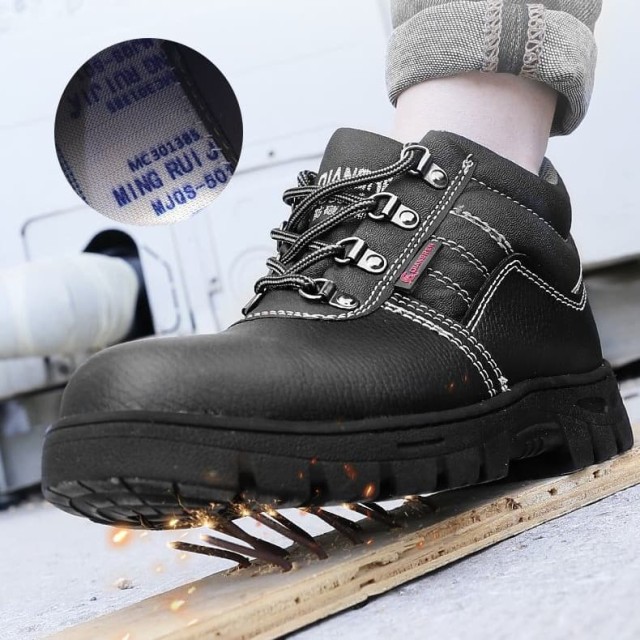For professionals in high-security environments, traditional steel-toe boots create a paradox: they protect feet from workplace hazards but disrupt workflows in metal-detector zones. Composite safety shoes solve this dilemma by delivering equivalent impact protection while enhancing operational efficiency.
Why Composite Safety Shoes Are Critical for Metal-Detector Work Zones
Solving the Steel-Toe Problem: Avoiding Disruptions in Security-Check Workflows
Steel-toe boots trigger metal detectors in airports, government facilities, and electronics plants—requiring removal and rescreening that wastes hundreds of work hours annually. Composite alternatives use advanced materials like Kevlar and carbon fiber to:
- Eliminate security delays by passing through detectors seamlessly
- Maintain continuous productivity in checkpoint-heavy environments
- Reduce compliance risks where metal-free footwear is mandated
Research confirms composite materials avoid the 5-7 minute per-person delay caused by steel-toe screenings in high-traffic facilities.
Certified Protection: How Composite Materials Meet Rigorous Safety Standards
Composite safety shoes aren’t just convenient—they’re rigorously tested. They meet the same ASTM F2413 standards as steel toes for:
- Impact resistance (75 ft-lbs force)
-
Compression protection (2,500 lbs load)
Key differences that give composites an edge:
| Feature | Steel Toe | Composite Toe |
|-----------------------|-------------------|---------------------|
| Weight | Heavy | ~30% lighter |
| Thermal Conductivity | Conducts heat/cold | Insulates better |
| Electrical Safety | Conductive | Non-conductive |
Aerospace technicians report 40% less foot fatigue after switching to composites for 12-hour shifts.
Beyond Metal-Free Design: The Multifaceted Value of Composite Safety Shoes
Ergonomics and Efficiency: Reducing Fatigue in High-Traffic Security Environments
The hidden cost of steel-toe boots manifests in worker fatigue. Composite designs address this through:
- Lightweight construction – Weighing about as much as athletic shoes
- Temperature regulation – Unlike steel, composites don’t freeze in cold storage or overheat near furnaces
- Flexible fit – Moldable materials reduce pressure points during long standing periods
An electronics manufacturer measured a 22% drop in shift-change foot complaints after adopting composite safety shoes.
Industry Proof: Where Leading Sectors Are Making the Switch
Forward-thinking industries now mandate composite safety footwear:
- Aviation security – TSA-compliant crews maintain faster screening throughput
- Cleanroom manufacturing – Prevents particulate contamination from metal wear
- Utilities work – Non-conductive protection against live wires
Government procurement data shows a 300% increase in composite shoe contracts for high-security facilities since 2020.
Upgrade Your Safety Footwear Strategy
3515 empowers distributors and bulk buyers with OSHA-compliant composite safety shoes that workers actually wear. Our manufacturing expertise delivers:
- Customizable designs for industry-specific needs
- Bulk-order efficiencies without compromising protection
- Future-proof solutions as more facilities adopt metal-detector policies
[Contact 3515] to explore safety footwear that protects both workers and operational continuity.
Related Products
- Puncture-Resistant Velcro Safety Boots for Wholesale & Custom Manufacturing
- Wholesale Customizable Suede Safety Boots - Puncture-Proof with Velcro Closure
- Wholesale Durable Safety Boots Manufacturer Customizable Steel Toe Work Boots
- Durable Steel Toe Safety Boots Wholesale & Custom Manufacturing
- Wholesale Suede Chelsea Safety Boots for Custom & Private Label Manufacturing
Related Articles
- How to Choose Steel Toe Boots: Safety, Comfort, and Job-Specific Features
- How to Reduce Foot Injury Risks in High-Risk Workplaces: 3 Proven Strategies
- Steel-Toe vs. Composite-Toe Boots: How to Choose the Right Safety Footwear for Your Job
- How to Choose Between Steel and Composite Toe Boots for Maximum Safety
- Matching Men’s Work Shoe Safety Technologies to Workplace Hazards



















